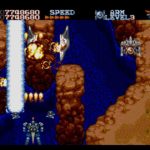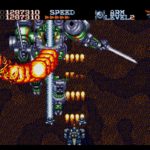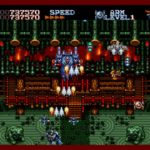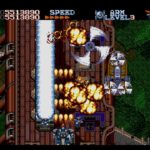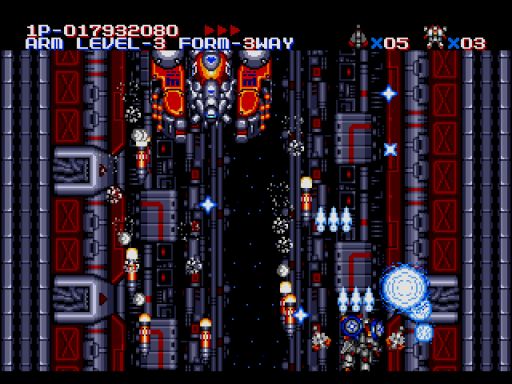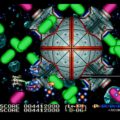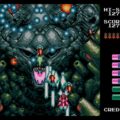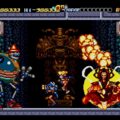Developer: Compile Publisher: Tengen Release: 1993 Genre: Shooter
The Sega CD is the butt of many jokes in plenty of circles. To some extent it does deserve some of the ridicule regarding its library. While Sega of Japan did a better job rounding out its library in all genres in the East Sega of America flooded the system with FMV garbage. Not that FMV games are bad by their nature but the limited color palette made those games look terrible. Playing Sewer Shark was like watching dookie hit you in the face at 50 mph. Those that dug deeper however found many gems. Robo Aleste is a fantastic shooter and one its best games, let alone shooters.
Robo Aleste is not a direct sequel to M.U.S.H.A but takes place in the same universe. In the year 1543 the war between feudal lords takes an interesting turn when steam powered mecha invade Japan. These mechs are reverse engineered and the war resumes. Out of the eight warlords Oda Nobunaga has gained the most territory. His progress sows jealousy and creates an alliance among the remaining war lords. As Kage, the last member of Nobunaga’s White Fang army you are tasked with defending your lord’s honor against the world.
The story in Robo Aleste is not too elaborate but interesting enough to propel the game forward. The game does a decent job explaining the presence of massive giant robots in Feudal Japan. This is a pretty interesting world all things considered and I like the deeper dive this game provides. While there are frequent cutscenes you didn’t come for the plot though. You came for the action of which Robo Aleste has it in spades.
In terms of gameplay a lot has changed but a lot is also still the same. The standard shots can upgrade to high level by collecting power chips. Of the primary weapons the blue lightning flash and orange exploding flower return. They are also joined by the throwing stars and yellow shadow formation. All four weapons are viable choices and have their niches plus can upgrade three levels. The lightning flash is the strongest, able to pierce walls and enemies. The exploding flowers cover a wide range and deal splash damage when they explode. However they can’t be aimed and suck at offering any kind of protection. The shuriken are powerful and cover your sides. Lastly the shadow formation is an aggressive homing weapon. Weapon drops are frequent enough that it is worth playing around with each one rather than settling on one favorite.
One area Robo Aleste takes a step back is with its pods. M.U.S.H.A. offered various formations your pods could assume which added to the gameplay tremendously. Playing around and figuring out the best formation in each situation was incredibly fun. But it was also game breaking when paired with certain weapons. The pods are absent and you feel their missing presence. Instead you have two side ships that mimic your current weapon and can be sent rocketing at enemies. It does not make up for it and is an afterthought. This shifts the focus back on the weapons and their quirks which. The lightning flash is strong but can also obscure your vision. The shadow formation forms a shield when not seeking enemies but also cannot manually target. These limitations encourage weapon switching although I still miss M.U.S.H.A.’s pod system.
Robo Aleste is a pretty long game at around eleven stages. That is both good and bad. Some drag on far too long such as the assault on the train line. Others are incredibly brief and feel more like an interlude. This is a slower game than its predecessor but is no less intense. Robo Aleste puts up a fight but never crosses into ridiculous territory. Although you die in a single hit and your weapon level resets new item drops are always present. You can actually shoot enemy bullets although they tend to blend into the background thanks to the color palette. The boss battles are a bit inconsistent. Some go down in seconds while others like Tetsuo are long battles of attrition. I found this to be more accessible than most shooters of the time however.
Where M.U.S.H.A mixed Japanese architecture with sci-fi elements Robo Aleste downplays them. There is no shortage of giant mechs but the game never loses sight of the year it takes place. I found M.U.S.H.A more visually appealing as it featured plenty of parallax scrolling and better art. Most of the levels here are flat and lifeless in comparison. There are highlights such as the nighttime raid on Mouri’s fortress but they are few. The cutscenes are packed into the latter half and only marred by lame voice acting. The soundtrack though is fantastic, hard techno that I listen to even outside of the game.
In Closing
Robo Aleste is the Sega CD’s best shooter and one of the best for the Genesis as well. It has stiff competition but is still that good in my opinion. This is an incredible game that sadly will probably never see a re-release. It is worth the moderate price it goes for now though.


